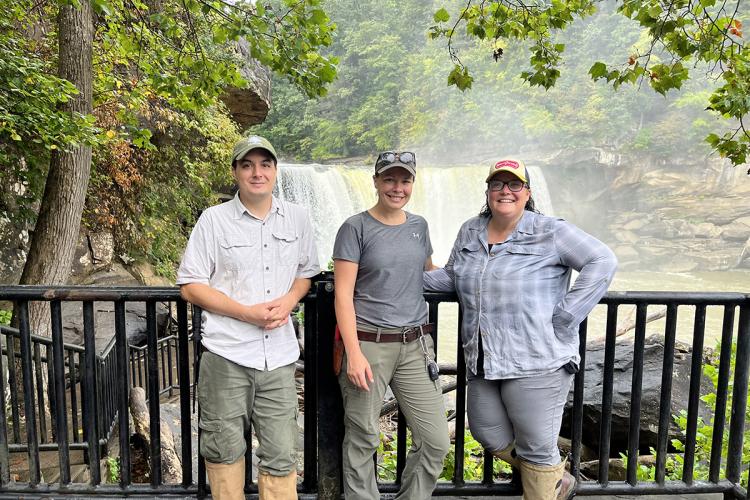Fall Harvest Season: Seed Collections & Partnerships
Fall Harvest Season: Seed Collections & Partnerships

Harvest season is upon us!
This is a time to gather crops and collect seeds from many of our native plant species. Most of our woody plants, including trees like oaks and hickories, bloom in the spring and take the entire growing season to produce mature fruit. In autumn, these fruits begin to ripen and fall from the trees for natural dispersal.
Collecting seeds from natural areas
The Arboretum's Native Plant Collection features plants that are grown from wild-collected seed across the state. Our team visits natural areas from each respective region to collect seed to be propagated for those areas of the collection. So far, this has been a very productive harvest season!
This year, we partnered with the U.S. National Arboretum and Morris Arboretum and Gardens to collect seed to grow for ex situ conservation in our living collections and to seed bank for future conservation purposes. During this week-long expedition to some of Kentucky's most beautiful natural areas, including the highest peak in the state – Black Mountain – we made 62 different collections. A few of our primary targets that we successfully collected during our travels include Canada yew (Taxus canadensis), mountain camellia (Stewartia ovata), and Fraser magnolia (Magnolia fraseri).
Visiting natural areas for seed collection not only enables us to know exactly where our seed is sourced and to grow plants that are not often cultivated, but also helps us to better understand each plant's preferred growing conditions, by seeing where it grows naturally.
Processing seed for germination
Our native plants team is currently busy processing seed from this trip by cleaning it thoroughly and prepping it to be sown in the greenhouse this winter. Many of our native seeds require specific conditions in order to break dormancy and germinate. Most commonly, seeds require a period of cool moist stratification. Seeds of some species may even require two cool moist periods with a warm moist period in between – this is known as “double dormancy." Other seeds may have a hard seed coat that requires some mechanical or chemical breaching of this protective layer in order to imbibe water and germinate (the technical term for this activity is scarification). Our team researches each individual species and prescribes what we think is needed for germination.
Conserving Kentucky yellowwood
In addition to collections made with partners from visiting arboreta, we are excited to be working on an ex situ conservation program for Kentucky yellowwood (Cladrastis kentukea). You might be familiar with the delicate chandelier-like inflorescences of yellowwood’s cream-colored blooms in the spring, and its smooth grey bark resembling that of a beech tree. Though this tree has been cultivated extensively for horticultural use, it is rarely seen in natural areas and is of conservation concern. In addition, there are few existing cultivated plants of known wild provenance (records of where these trees were originally sourced). Our goal is to grow plants from seed collected in Kentucky at The Arboretum and maintain detailed records about these trees, for future research and conservation purposes.
Challenges of collecting Kentucky yellowwood seed
Regionally, Kentucky yellowwood can be found growing naturally in the Kentucky River Palisades on the calcareous rocky slopes above the Kentucky River. Disjunct populations can also be found in other parts of the state, including the Jellico Mountains and Big South Fork in southern Kentucky. One challenge with collecting Kentucky yellowwood is its irregular and unreliable production of seed. Individual trees may produce many bean-like pods but few seeds (if any) within these pods. Another challenge is reaching these pods before they fall to the ground and risk being consumed or destroyed by hungry insects.
Success in 2023
Luckily for us, 2023 was an excellent year for this species in Kentucky! The trees we found produced plenty of seeds to grow for our collection as well as some to share with other arboreta and seed banks. In order to access these seeds, we sought out locations where the trees grow beneath cliffs, so that we could reach them from above their canopy. This wasn’t possible in all cases – for one of our collections we were assisted by UK’s Lead Arborist, Kyle Youngs, who skillfully climbed an adjacent blue ash tree to gather seed that was otherwise far out of our reach from the ground.
Thanks to our success this year and the help of other partners who are also interested in yellowwood conservation – in particular Julian Campbell, Charley Sither, and Tara Littlefield – we will be growing five different collections of yellowwood next year. We look forward to sharing these trees, and other gems from our explorations across Kentucky, with Arboretum visitors.
